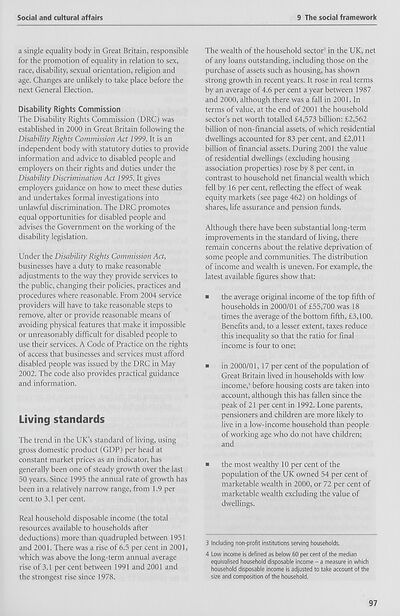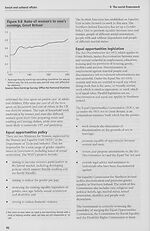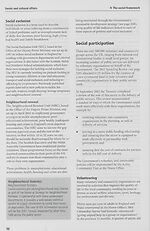Download files
Complete book:
Individual page:
Thumbnail gallery: Grid view | List view

Social and cultural affairs
9 The social framework
a single equality body in Great Britain, responsible
for the promotion of equality in relation to sex,
race, disability, sexual orientation, religion and
age. Changes are unlikely to take place before the
next General Election.
Disability Rights Commission
The Disability Rights Commission (DRC) was
established in 2000 in Great Britain following the
Disability Rights Commission Act 1999. It is an
independent body with statutory duties to provide
information and advice to disabled people and
employers on their rights and duties under the
Disability Discrimination Act 1995. It gives
employers guidance on how to meet these duties
and undertakes formal investigations into
unlawful discrimination. The DRC promotes
equal opportunities for disabled people and
advises the Government on the working of the
disability legislation.
Under the Disability Rights Commission Act,
businesses have a duty to make reasonable
adjustments to the way they provide services to
the public, changing their policies, practices and
procedures where reasonable. From 2004 service
providers will have to take reasonable steps to
remove, alter or provide reasonable means of
avoiding physical features that make it impossible
or unreasonably difficult for disabled people to
use their services. A Code of Practice on the rights
of access that businesses and services must afford
disabled people was issued by the DRC in May
2002. The code also provides practical guidance
and information.
Living standards
The trend in the UK’s standard of living, using
gross domestic product (GDP) per head at
constant market prices as an indicator, has
generally been one of steady growth over the last
50 years. Since 1995 the annual rate of growth has
been in a relatively narrow range, from 1.9 per
cent to 3.1 per cent.
Real household disposable income (the total
resources available to households after
deductions) more than quadrupled between 1951
and 2001. There was a rise of 6.5 per cent in 2001,
which was above the long-term annual average
rise of 3.1 per cent between 1991 and 2001 and
the strongest rise since 1978.
The wealth of the household sector3 in the UK, net
of any loans outstanding, including those on the
purchase of assets such as housing, has shown
strong growth in recent years. It rose in real terms
by an average of 4.6 per cent a year between 1987
and 2000, although there was a fall in 2001. In
terms of value, at the end of 2001 the household
sector’s net worth totalled £4,573 billion: £2,562
billion of non-fmancial assets, of which residential
dwellings accounted for 83 per cent, and £2,011
billion of financial assets. During 2001 the value
of residential dwellings (excluding housing
association properties) rose by 8 per cent, in
contrast to household net financial wealth which
fell by 16 per cent, reflecting the effect of weak
equity markets (see page 462) on holdings of
shares, life assurance and pension funds.
Although there have been substantial long-term
improvements in the standard of living, there
remain concerns about the relative deprivation of
some people and communities. The distribution
of income and wealth is uneven. For example, the
latest available figures show that:
■ the average original income of the top fifth of
households in 2000/01 of £55,700 was 18
times the average of the bottom fifth, £3,100.
Benefits and, to a lesser extent, taxes reduce
this inequality so that the ratio for final
income is four to one;
■ in 2000/01, 17 per cent of the population of
Great Britain lived in households with low
income,4 before housing costs are taken into
account, although this has fallen since the
peak of 21 per cent in 1992. Lone parents,
pensioners and children are more likely to
live in a low-income household than people
of working age who do not have children;
and
■ the most wealthy 10 per cent of the
population of the UK owned 54 per cent of
marketable wealth in 2000, or 72 per cent of
marketable wealth excluding the value of
dwellings.
3 Including non-profit institutions serving households.
4 Low income is defined as below 60 per cent of the median
equivalised household disposable income - a measure in which
household disposable income is adjusted to take account of the
size and composition of the household.
97
9 The social framework
a single equality body in Great Britain, responsible
for the promotion of equality in relation to sex,
race, disability, sexual orientation, religion and
age. Changes are unlikely to take place before the
next General Election.
Disability Rights Commission
The Disability Rights Commission (DRC) was
established in 2000 in Great Britain following the
Disability Rights Commission Act 1999. It is an
independent body with statutory duties to provide
information and advice to disabled people and
employers on their rights and duties under the
Disability Discrimination Act 1995. It gives
employers guidance on how to meet these duties
and undertakes formal investigations into
unlawful discrimination. The DRC promotes
equal opportunities for disabled people and
advises the Government on the working of the
disability legislation.
Under the Disability Rights Commission Act,
businesses have a duty to make reasonable
adjustments to the way they provide services to
the public, changing their policies, practices and
procedures where reasonable. From 2004 service
providers will have to take reasonable steps to
remove, alter or provide reasonable means of
avoiding physical features that make it impossible
or unreasonably difficult for disabled people to
use their services. A Code of Practice on the rights
of access that businesses and services must afford
disabled people was issued by the DRC in May
2002. The code also provides practical guidance
and information.
Living standards
The trend in the UK’s standard of living, using
gross domestic product (GDP) per head at
constant market prices as an indicator, has
generally been one of steady growth over the last
50 years. Since 1995 the annual rate of growth has
been in a relatively narrow range, from 1.9 per
cent to 3.1 per cent.
Real household disposable income (the total
resources available to households after
deductions) more than quadrupled between 1951
and 2001. There was a rise of 6.5 per cent in 2001,
which was above the long-term annual average
rise of 3.1 per cent between 1991 and 2001 and
the strongest rise since 1978.
The wealth of the household sector3 in the UK, net
of any loans outstanding, including those on the
purchase of assets such as housing, has shown
strong growth in recent years. It rose in real terms
by an average of 4.6 per cent a year between 1987
and 2000, although there was a fall in 2001. In
terms of value, at the end of 2001 the household
sector’s net worth totalled £4,573 billion: £2,562
billion of non-fmancial assets, of which residential
dwellings accounted for 83 per cent, and £2,011
billion of financial assets. During 2001 the value
of residential dwellings (excluding housing
association properties) rose by 8 per cent, in
contrast to household net financial wealth which
fell by 16 per cent, reflecting the effect of weak
equity markets (see page 462) on holdings of
shares, life assurance and pension funds.
Although there have been substantial long-term
improvements in the standard of living, there
remain concerns about the relative deprivation of
some people and communities. The distribution
of income and wealth is uneven. For example, the
latest available figures show that:
■ the average original income of the top fifth of
households in 2000/01 of £55,700 was 18
times the average of the bottom fifth, £3,100.
Benefits and, to a lesser extent, taxes reduce
this inequality so that the ratio for final
income is four to one;
■ in 2000/01, 17 per cent of the population of
Great Britain lived in households with low
income,4 before housing costs are taken into
account, although this has fallen since the
peak of 21 per cent in 1992. Lone parents,
pensioners and children are more likely to
live in a low-income household than people
of working age who do not have children;
and
■ the most wealthy 10 per cent of the
population of the UK owned 54 per cent of
marketable wealth in 2000, or 72 per cent of
marketable wealth excluding the value of
dwellings.
3 Including non-profit institutions serving households.
4 Low income is defined as below 60 per cent of the median
equivalised household disposable income - a measure in which
household disposable income is adjusted to take account of the
size and composition of the household.
97
Set display mode to:
![]() Universal Viewer |
Universal Viewer | ![]() Mirador |
Large image | Transcription
Mirador |
Large image | Transcription
The item on this page appears courtesy of Office for National Statistics and may be re-used under the Open Government Licence for Public Sector Information.
| Britain and UK handbooks > UK: The official yearbook of the United Kingdom of Great Britain and Northern Ireland > 2003 > (119) |
|---|
| Permanent URL | https://digital.nls.uk/204924654 |
|---|
| Attribution and copyright: |
|
|---|---|
| Description | Three volumes of 'UK: The official yearbook of the United Kingdom of Great Britain and Northern Ireland', published annually by the Office of National Statistics from 2002-2005. |
|---|---|
| Shelfmark | GII.11 SER |
| Description | Three titles produced by the British Government from 1954-2005 describing 'how Britain worked'. They are: 'Britain: An official handbook' (1954-1998), 'Britain: The official yearbook of the United Kingdom' (1999-2001), and 'UK: The official yearbook of the United Kingdom of Great Britain and Northern Ireland' (2002-2005). These 50 reports provide an overview of Britain's economic, social and cultural affairs, its environment, international relations, and the systems of government. They give an impartial summary of government policies and initiatives, and explain how public services are organised. |
|---|---|
| Additional NLS resources: |
|

